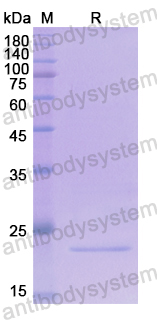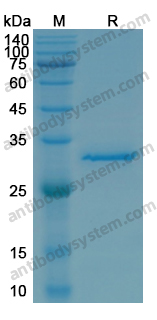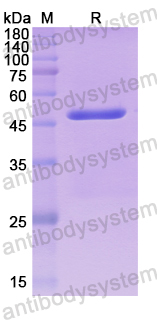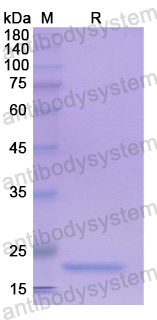Catalog No.
YHA44301
Expression system
E. coli
Species
Homo sapiens (Human)
Protein length
Met1-Gly165
Predicted molecular weight
21.63 kDa
Nature
Recombinant
Endotoxin level
Please contact with the lab for this information.
Purity
>90% as determined by SDS-PAGE.
Accession
O15182
Applications
ELISA, Immunogen, SDS-PAGE, WB, Bioactivity testing in progress
Form
Lyophilized
Storage buffer
Lyophilized from a solution in PBS pH 7.4, 0.02% NLS, 1mM EDTA, 4% Trehalose, 1% Mannitol.
Reconstitution
Reconstitute in sterile water for a stock solution. A copy of datasheet will be provided with the products, please refer to it for details.
Shipping
In general, proteins are provided as lyophilized powder/frozen liquid. They are shipped out with dry ice/blue ice unless customers require otherwise.
Stability and Storage
Use a manual defrost freezer and avoid repeated freeze thaw cycles. Store at 2 to 8°C for frequent use. Store at -20 to -80°C for twelve months from the date of receipt.
Alternative Names
CEN3, CETN3, Centrin-3
Identification and Mendelian randomization validation of pathogenic gene biomarkers in obstructive sleep apnea., PMID:39220737
Centrins control chicken cone cell lipid droplet dynamics through lipid-droplet-localized SPDL1., PMID:37699389
Comprehensive analysis of RNA-binding protein SRSF2-dependent alternative splicing signature in malignant proliferation of colorectal carcinoma., PMID:36623729
The Male Mouse Meiotic Cilium Emanates from the Mother Centriole at Zygotene Prior to Centrosome Duplication., PMID:36611937
Bioluminescent Ratiometric Indicator for Analysis of Water Hardness in Household Water., PMID:32498467
ACTG1 and TLR3 are biomarkers for alcohol-associated hepatocellular carcinoma., PMID:30675230
Deletion of both centrin 2 (CETN2) and CETN3 destabilizes the distal connecting cilium of mouse photoreceptors., PMID:30647131
Coupling bimolecular PARylation biosensors with genetic screens to identify PARylation targets., PMID:29789535
ADGRV1 is implicated in myoclonic epilepsy., PMID:29266188
Electrochemical behavior of hemin binding with human centrin 3., PMID:28499167
Tumor Profiling: Adding Proteomics to Genomics., PMID:27354270
Proteogenomics connects somatic mutations to signalling in breast cancer., PMID:27251275
Centrin 3 is an inhibitor of centrosomal Mps1 and antagonizes centrin 2 function., PMID:26354417
Centrin-2 (Cetn2) mediated regulation of FGF/FGFR gene expression in Xenopus., PMID:26014913
MagFRET: the first genetically encoded fluorescent Mg2+ sensor., PMID:24312622
CETN1 is a cancer testis antigen with expression in prostate and pancreatic cancers., PMID:24252580
MEF2C deletions and mutations versus duplications: a clinical comparison., PMID:23402836
Relative stability of human centrins and its relationship to calcium binding., PMID:23346931
The two human centrin homologues have similar but distinct functions at Tetrahymena basal bodies., PMID:23087207
Whole blood genome-wide gene expression profile in males after prolonged wakefulness and sleep recovery., PMID:22947657
A role for primary cilia in glutamatergic synaptic integration of adult-born neurons., PMID:22306608
Defective nucleotide excision repair with normal centrosome structures and functions in the absence of all vertebrate centrins., PMID:21482720
TPCK targets elements of mitotic spindle and induces cell cycle arrest in prometaphase., PMID:20381455
Calcium and magnesium binding to human centrin 3 and interaction with target peptides., PMID:15654740
Differential expression and interaction with the visual G-protein transducin of centrin isoforms in mammalian photoreceptor cells., PMID:15347651
Identification of novel molecular components of the photoreceptor connecting cilium by immunoscreens., PMID:11846514
Characterization of the X-linked murine centrin Cetn2 gene., PMID:11250075
Differential expression and cellular distribution of centrin isoforms during human ciliated cell differentiation in vitro., PMID:10725219
A role for centrin 3 in centrosome reproduction., PMID:10662768
Identification of a new mammalian centrin gene, more closely related to Saccharomyces cerevisiae CDC31 gene., PMID:9256449




